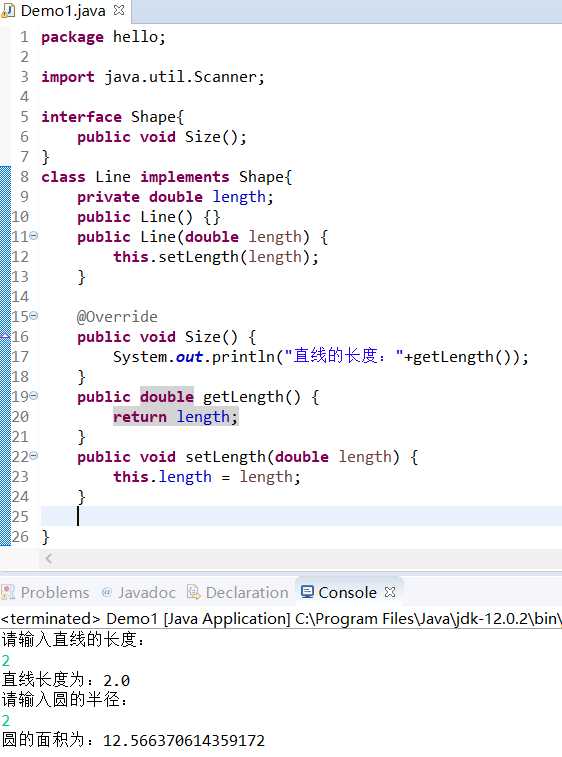标签:内容 class int() 编程技巧 triangle 访问 prot next import
1、设计一个类层次,定义一个抽象类--形状,其中包括有求形状的面积的抽象方法。 继承该抽象类定义三角型、矩形、圆。 分别创建一个三角形、矩形、圆存对象,将各类图形的面积输出。
注:三角形面积s=sqrt(p(p-a)(p-b)*(p-c)) 其中,a,b,c为三条边,p=(a+b+c)/2
2、编程技巧
(1) 抽象类定义的方法在具体类要实现;
(2) 使用抽象类的引用变量可引用子类的对象;
(3) 通过父类引用子类对象,通过该引用访问对象方法时实际用的是子类的方法。可将所有对象存入到父类定义的数组中。
package hello;
import java.util.Scanner;
abstract class Shape {
public abstract double Area();
}
class Triangle extends Shape{
private int a,b,c;
public Triangle() {}
public Triangle(int a,int b,int c){
this.a = a;
this.b = b;
this.c = c;
}
public int getA() {
return a;
}
public void setA(int a) {
this.a = a;
}
public int getB() {
return b;
}
public void setB(int b) {
this.b = b;
}
public int getC() {
return c;
}
public void setC(int c) {
this.c = c;
}
public double Area() {
double p = (a+b+c)/2;
return Math.sqrt(p*(p-getA())*(p-getB())*(p-getC()));
}
}
class Rectangle extends Shape{
private double height,width;
public Rectangle() {}
public Rectangle(double height,double width){
this.height = height;
this.width = width;
}
public double getHeight() {
return height;
}
public void setHeight(double height) {
this.height = height;
}
public double getWidth() {
return width;
}
public void setWidth(double width) {
this.width = width;
}
public double Area() {
return getHeight()*getWidth();
}
}
class Circle extends Shape{
private double radius;
public Circle(){}
public Circle(double radius) {
this.radius = radius;
}
public double getRadius() {
return radius;
}
public void setRadius(double radius) {
this.radius = radius;
}
public double Area() {
return Math.PI*Math.pow(getRadius(), 2);
}
}
public class Demo2{
public static void main(String[] args) {
System.out.println("请输入三角形的边长:");
Scanner s1 = new Scanner(System.in);
int a = s1.nextInt();
int b = s1.nextInt();
int c = s1.nextInt();
Triangle triangle = new Triangle(a,b,c);
if(a+b>c && a+c>b && b+c>a) {
System.out.println("三角形的面积为:"+triangle.Area());
}
else {
System.out.println("这不是一个三角形,无法输出面积。");
}
Scanner s2 = new Scanner(System.in);
System.out.println("请输入矩形的长和宽:");
double height = s2.nextDouble();
double width = s2.nextDouble();
Rectangle rectangle = new Rectangle(height,width);
System.out.println("矩形的面积为:"+rectangle.Area());
Scanner s3 = new Scanner(System.in);
System.out.println("请输入圆的半径:");
double radius = s3.nextDouble();
Circle circle = new Circle(radius);
System.out.println("圆的面积为:"+circle.Area());
}
}

(二)使用接口技术
1、定义接口Shape,其中包括一个方法size(),设计“直线”、“圆”、类实现Shape接口。分别创建一个“直线”、“圆”对象,将各类图形的大小输出。
2、编程技巧
(1) 接口中定义的方法在实现接口的具体类中要重写实现;
(2) 利用接口类型的变量可引用实现该接口的类创建的对象。
package hello;
import java.util.Scanner;
interface Shape{
public void Size();
}
class Line implements Shape{
private double length;
public Line() {}
public Line(double length) {
this.setLength(length);
}
@Override
public void Size() {
System.out.println("直线的长度:"+getLength());
}
public double getLength() {
return length;
}
public void setLength(double length) {
this.length = length;
}
}
class Circle implements Shape{
private double radius;
public Circle(double radius) {
this.radius = radius;
}
public double getRadius() {
return radius;
}
public void setRadius(double radius) {
this.radius = radius;
}
public double getArea() {
return Math.PI*Math.pow(radius, 2);
}
@Override
public void Size() {
System.out.println("圆的面积:"+getArea());
}
}
public class Demo1{
public static void main(String[] args) {
Scanner s = new Scanner(System.in);
System.out.println("请输入直线的长度:");
int length = s.nextInt();
Line line = new Line(length);
System.out.println("直线长度为:"+line.getLength());
Scanner p = new Scanner(System.in);
System.out.println("请输入圆的半径:");
double radius = p.nextDouble();
Circle circle = new Circle(radius);
System.out.println("圆的面积为:"+circle.getArea());
}
}

通过以上两道题区分抽象类和接口
比较|抽象类|接口
-|-|-
实现方法|子类使用extends关键字来继承抽象类,如果子类不是抽象类,子类需要提供抽象类中所有声明方法的实现|子类使用implements来实现接口,需要提供接口中所有声明的实现|
和正常类区别|抽象类不能被实例化|接口则是完全不同的类型|
访问修饰符|抽象方法可以有public,protected和default等修饰|接口默认是public,不能使用其他修饰符|
多继承|一个子类只能存在一个父类|一个子类可以存在多个接口|
添加新方法|向抽象类中添加新方法,可以提供默认的实现,因此可以不修改子类现有的代码|如果往接口中添加新方法,则子类中需要实现该方法.|
标签:内容 class int() 编程技巧 triangle 访问 prot next import
原文地址:https://www.cnblogs.com/clayLJX/p/11657772.html